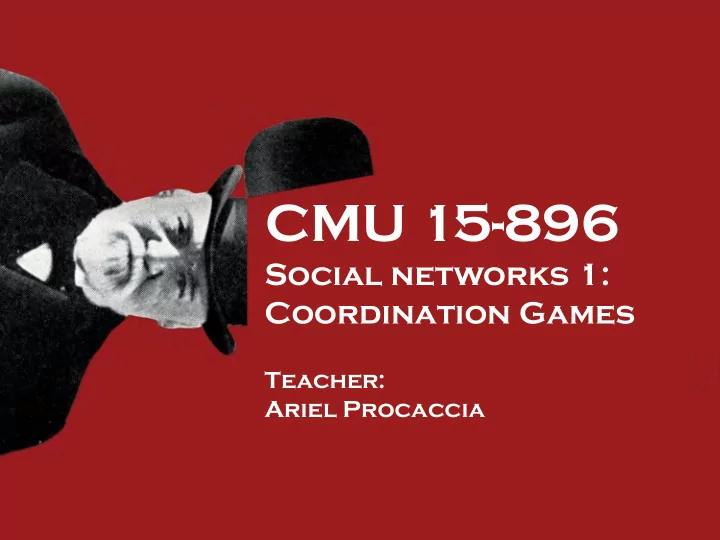

CMU 15-896 Social networks 1: Coordination Games Teacher: Ariel Procaccia
Background • Spread of ideas and new behaviors through a population • Examples: Religious beliefs and political movements o Adoption of technological innovations o Success of new product o • Process starts with early adopters and spreads through the social network 15896 Spring 2016: Lecture 23 2
Networked coordination games • Simple model for the diffusion of ideas and innovations • Social network is undirected graph • Choice between old behavior and new behavior • Parametrized by 15896 Spring 2016: Lecture 23 3
Networked coordination games • Rewards for and when : If both choose � , they receive � o If both choose � , they receive 1 � � o Otherwise both receive 0 o • Overall payoff to = sum of payoffs � = #neighbors • Denote � = degree of , � playing � reward from • Payoff to from choosing is � � choosing is � � adopts if � is a threshold • � 15896 Spring 2016: Lecture 23 4
Cascading behavior • Each node simultaneously updates its behavior in discrete time steps • Nodes in initially adopt set of nodes adopting after one • � round � after rounds of updates • � • Question: When does a small set of nodes convert the entire population? 15896 Spring 2016: Lecture 23 5
Contagion threshold is countably infinite and each � is finite • � is converted by if s.t. • � is contagious if every node is converted • • It is easier to be contagious when is small • Contagion threshold of = max s.t. finite contagious set 15896 Spring 2016: Lecture 23 6
Example � � 1 2 � � 1 � � 2 � � 3 � � 4 Poll 1: What is the contagion threshold of � ? 15896 Spring 2016: Lecture 23 7
Example Poll 2: What is the contagion threshold of � ? 15896 Spring 2016: Lecture 23 8
Progressive processes • Nonprogressive process: Nodes can switch from to or to • Progressive process: Nodes can only switch from to • As before, a node switches to if a fraction of its neighbors follow set of nodes adopting in • � � progressive process; define � as before 15896 Spring 2016: Lecture 23 9
Progressive processes • With progressive processes intuitively the contagion threshold should be at least as high • Theorem [Morris, 2000]: For any graph , finite contagious set wrt finite � contagious set wrt � • I.e., the contagion threshold is identical under both models 15896 Spring 2016: Lecture 23 10
Proof of theorem � ��� • Lemma: � � � • Proof: � � ��� ��� � � � � o � ��� ��� ��� � � � � � o ��� ��� For every , , � � � o because has at least as many neighbors as when it converted ��� Clearly � � o 15896 Spring 2016: Lecture 23 11
Proof of theorem • Enough to show: given a set that is contagious wrt � , there is a set that is contagious wrt � ℓ ; this is our • Let s.t. � � ��� • For , � by the � � lemma ��� ��� • Since , , and � � � � ��� hence � � � • By induction, all , � ��ℓ ℓ ��ℓ � � � � 15896 Spring 2016: Lecture 23 12
Contagion threshold • Saw a graph with contagion threshold • Does there exist a graph with contagion threshold ? • The previous theorem allows us to focus on the progressive case • Theorem [Morris, 2000]: For any graph , the contagion threshold 15896 Spring 2016: Lecture 23 13
Proof of theorem • Let � � 1/2 , finite � � ��� � � • Denote � � � � • � � � set of edges with exactly one end in � • If � ��� � � � then � � � � � � ��� For each � ∈ � � ∖ � ��� , its edges into � ��� are in o � � ��� ∖ � � � , and its edges into � ∖ � � are in � � � ∖ � � ��� More of the former than the latter because � o converted and � � 1/2 • ���� is finite and � � � � 0 for all � ∎ 15896 Spring 2016: Lecture 23 14
More general models • Directed graphs to model asymmetric influence • Redefine • Assume progressive contagion • Node is active if it adopts activated if switches from to 15896 Spring 2016: Lecture 23 15
Linear threshold model • Nonnegative weight �� for each edge otherwise �� • Assume � �� • Each has threshold � becomes active if • �� � active � 15896 Spring 2016: Lecture 23 16
General threshold model • Linear model assumes additive influences Switch if two co-workers and three family o members switch? has a monotonic function � defined • on subsets becomes activated if the activated subset • satisfies � � 15896 Spring 2016: Lecture 23 17
The cascade model • When s.t. is active and is not, has one chance to activate has an incremental function � = • probability that activates when have tried and failed • Special cases: Diminishing returns: � � o when Independent cascade: � �� o 15896 Spring 2016: Lecture 23 18
Recommend
More recommend